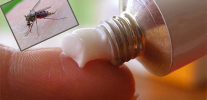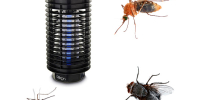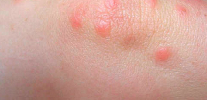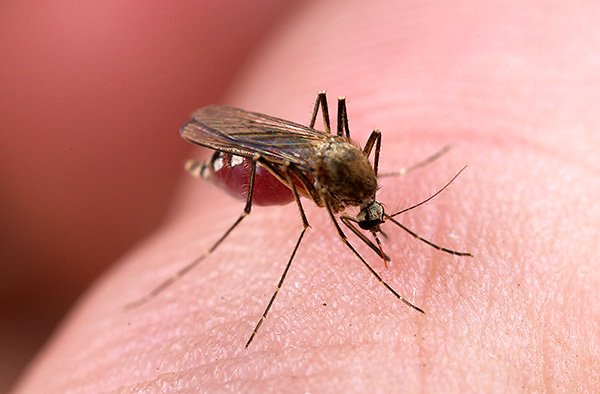
Next you will find out:
- What types of remedies for insect bites exist today and how do they fundamentally differ from each other;
- Features of the use of repellent sprays, aerosols, gels and creams - what should be the chemical composition of a really effective means and what one form is better or worse than the other;
- What is insecticidal repellent smoke bombs and spirals from insects and in what cases it is advisable to use them;
- When it makes sense to use electric ultraviolet insect killers and whether ultrasonic mosquito repellers are as effective as advertising claims;
- What else can be protected from bites? blood-sucking insects, as well as from the bites of wasps, hornets and leeches, and what to do if insects did bite you ...
Generally speaking, the means used today to protect against insect bites are very diverse, and are not limited to the usual creams and sprays. All kinds of repellent bracelets, ultrasonic repellers, electric insect killers, special protective clothing, as well as smokeballs and spirals that repel the midges — all this sometimes gives a good effect in practice, but creates a problem of choice for the consumer.
And indeed, the question arises: which remedy for insect bites is better suited for a given case - for fishing, walking in the forest, or, for example, relaxing in the gazebo at the cottage? .. In this question we will go further and try to understand it in more detail.

All the variety of commercially available products designed to protect against insect bites, on the basis of its action can be divided into the following groups:
- Chemical deterrent action for application to the body or clothing. The form of their release can be different - cream, gels, sprays, aerosols, as well as various accessories for wearing (for example, bracelets). The active substance of such agents is a special chemical compound possessing a repellent (i.e. repelling) effect in relation to a certain group of insects.And in one preparation several repellents of different chemical nature can be contained at once;

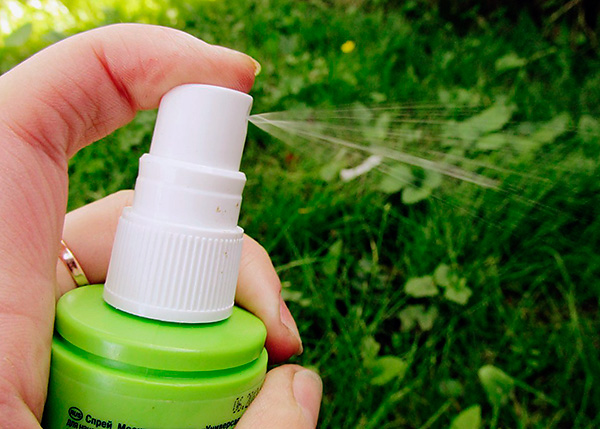
- Chemicals of the scaring and destroying action of the fumigation type. Simply put - these tools protect against insects and their bites by forming smoke (or steam) containing some amount of insecticide. In small doses and with not very long exposures, such smoke repels insects, and in higher concentrations or with prolonged exposures can kill them. These include, for example, smoke bombs from insects, mosquito coils, fumigators for domestic use;
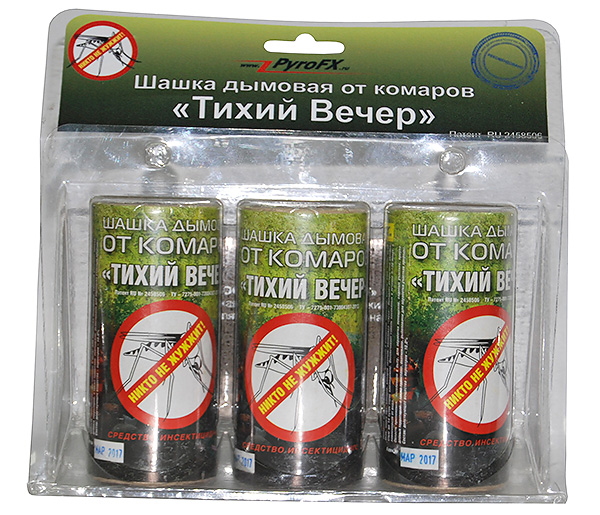

- Ultrasonic insect repellents. Despite the fact that today some manufacturers are trying to position such devices as a means of scaring almost any insects (bugs, fleas, flies, cockroaches, etc.), but practice shows that in reality the effect is not always the case. achieved only against mosquitoes;
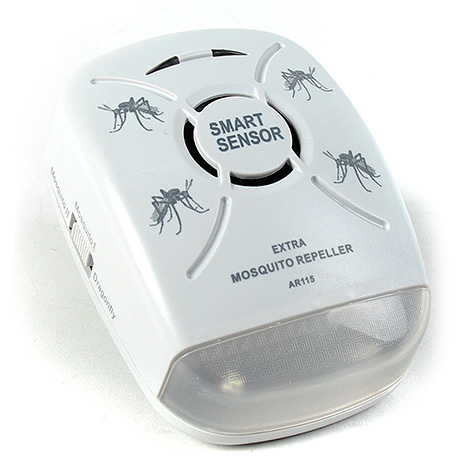
- Electric tube insect killers - used to protect against insect bites in a closed room (apartment, house), and on the street.The device massively attracts midges with the light of a special ultraviolet lamp and destroys insects with an electric discharge. Such devices can work not only from the outlet, but also from the built-in battery, infected with a solar battery;
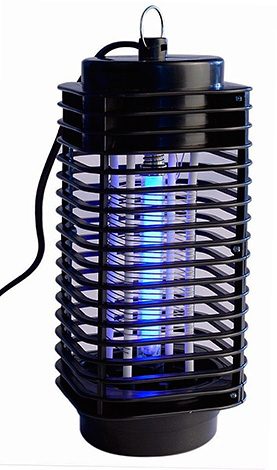
- And, finally, a very effective remedy for insect bites - both blood-sucking and any other - is special protective clothing.

Let's consider in more detail the important nuances of the use of these types of tools.
Sprays and aerosols for insect bites: how effective and safe are they?
In general, sprays and aerosols for insect bites are quite convenient means for a single or rare irregular use. After they are applied, a small amount of a chemical repellent that repels mosquitoes, mosquitoes, midges and (or) ticks remains on the skin or clothing, depending on the purpose of the preparation.
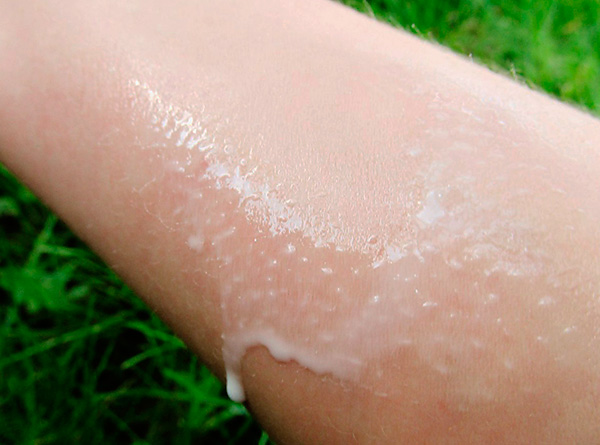
On a note
The difference between sprays and aerosols is that in the case of a spray, the active composition is pushed out of the nozzle by the pressure generated by pressing the sprayer, while in the case of using an aerosol can the composition is pushed out due to the expansion of the liquefied gas in the cartridge.Thus, the use of an aerosol agent can quite relieve the task, if necessary, to process a large number of people in a short period of time.
Many insect sprays (and aerosol preparations) contain DETA (diethyltoluamide) and pyrethroids (for example, alpha-cypermethrin) as active substances. Separate preparations are based on more modern and safer repellents (for example, the repellent IR3535, which is a derivative of the natural amino acid beta-alanine).
The amount of the classic and quite effective repellent DEET in sprays usually varies depending on what protection from insect bites is intended to provide the drug and how long this protection should last. For example, sprays and aerosols for the so-called professional protection against insect bites in the wild can contain up to 50% DETA, while preparations for protecting children from mosquito bites during a walk contain 7-10% DETA.
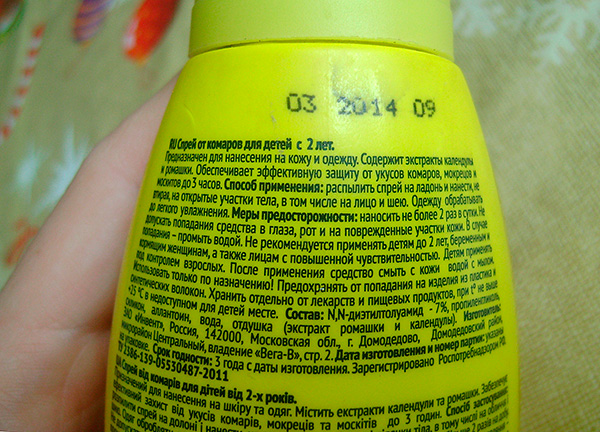
Products containing DETA above 15% provide a fairly well pronounced scaring of ticks, however, for reliable protection, it is desirable to choose drugs that additionally contain an insecticide from the group of pyrethroids.
In general, a high-quality spray or aerosol can rather confidently protect oneself from mosquito bites and midges anywhere — even at the dacha, at least in the woods or fishing.
On a note
It is believed that with a one-time and irregular use of funds from insect bites, the concentration of DETA in them up to 10% is safe for babies. If the baby needs to be protected from insects regularly, it is best to do without the use of chemical repellents.
The most popular sprays and sprays from insect bites are the trade name DETA of the same name as the repellent, as well as Mosquitall, Off, Neotox, Taiga and others. Some manufacturers have a large number of products targeted at different age groups and protecting against various insects.
A significant lack of sprays and aerosol preparations is the possibility of side effects during their inhalation and prolonged contact with the skin, especially in people prone to allergic reactions. Sometimes with rare use of problems does not occur, but if the tool is used regularly, then the likelihood of skin irritation, intoxication and allergic reactions increases.
Repellent gels and creams
Gels and creams from insect bites on the basis of their action are in many ways similar to sprays and aerosol preparations, with the only difference that instead of spraying the product is applied to open skin and rubbed on them. The active ingredient of such gels and creams is, as a rule, all the same diethyltoluamide (DETA).
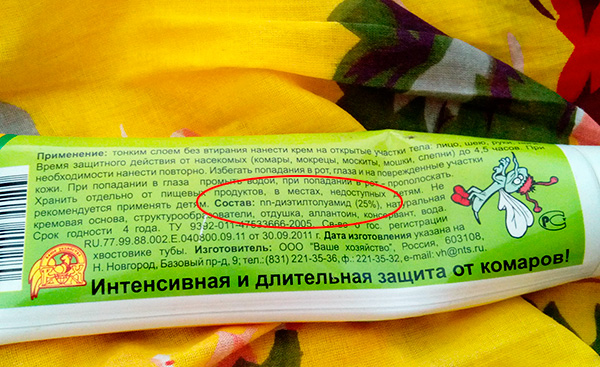
On a note
In addition, milk products are also available for children to be applied to the skin - they protect against mosquito bites, mosquitoes, midges, and biting midges. Also based on DEET.
Children's cream containing the repellent IR3535 are also quite effective against insect bites.
However, in general, the popularity of gels and insect bites from consumers is somewhat inferior to sprays due to the complexity of applying the drug to the body: if you simply sprinkle spray on clothes or skin, the gel should be carefully rubbed over the skin without losing a single unprotected plot.
Repellent creams and gels are comparable in duration to the protection against insect bites with sprays and aerosol preparations: the duration of protection is usually 2-4 hours.For this reason, for example, hunters and fishermen will need to handle the hands and face with the neck several times a day, which is not always convenient in the case of creams and gels.
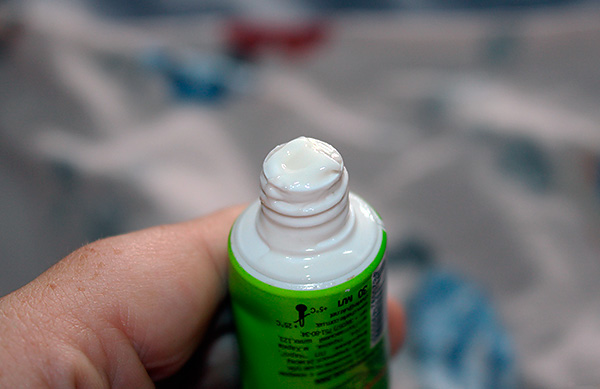
In addition, creams and gels for insect bites are contraindicated in dermatitis, psoriasis, eczema, furunculosis and some other skin diseases, and they are not recommended for pregnant and lactating women.
Among the creams and gels are available as "adult" drugs, and specialized tools for the protection of children. For example, “DETA Kid” is a cream in a tube that contains DETA and does not cause side effects when used irregularly. Similar drugs are manufactured by Off, Mosquitall and some others.
On a note
Sometimes they try to protect themselves from insects with the help of natural essential oils, putting them on clothes or on the skin. However, in reality, the essential oils from insect bites usually do not help very effectively: although blood-sucking parasites do not like strong, strong odors, however, with a large number of blood suckers around, such protection will not help.
However, when there are not many mosquitoes and they are not too aggressive, the essential oil, for example, lavender is quite capable of providing a deterrent effect and save from unpleasant bites.
Insect smoke bombs
Insecticidal repellent smoke bombs scare away mosquitoes, biting midges, midges and gnats from the territory in general, and when used in confined spaces, destroy insects in it. For example, by using a sword in nature, you can relax in the future without listening to the continuous squeak of mosquitoes around you, and if you light such a sword, for example, in a room, not only mosquitoes and flies will die, but also cockroaches, ants and other unwanted "guests ".
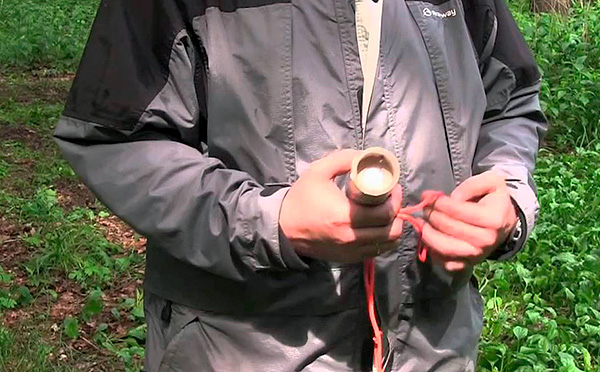
One of the drawbacks of insecticidal repellent smoke bombs is repelling insects only from a strictly defined area. That is, they are well suited for fishing and gatherings around the fire, but if you want, for example, to walk into the forest nearby, then insect bites will have to use something else (spray, spray or cream). Therefore, smoke bombs are not suitable for protection against insect bites on excursions or during active stages of hiking.
In addition, insecticidal repellent checkers do not provide reliable protection against the bites of ticks and spiders - those arthropods who cannot quickly leave the territory. After using the checkers, their activity on the smoke-treated area will significantly decrease, but these funds will not provide guaranteed protection against bites.
Today, the following insect checkers are quite popular and quite affordable:
- Quiet evening;
- City;
- Climate;
- Digital;
- Yamal
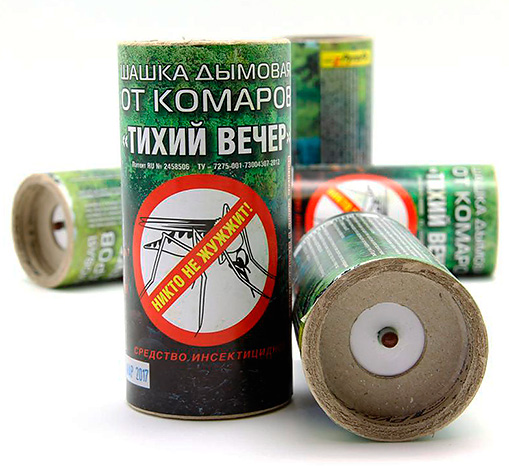

On a note
Smoke bombs on the basis of modern insecticides from the group of pyrethroids (permethrin and cypermethrin are commonly used) are most effective and safe for health. But sulfur fumes from insects is better not to use - these tools are more suitable for dealing with mold, for example, in greenhouses and basements.
It is also not recommended to use insecticidal checkers based on hexachlorane (another name is hexachlorocyclohexane) due to the high toxicity of this substance and its ability to accumulate in the body. An example is the G-17 checker.
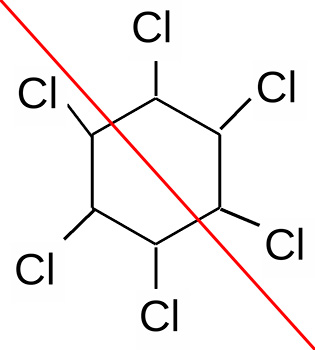
The cost of insecticidal repellent smoke bombs usually varies from 400-800 rubles per piece.
The order of application is as follows: the fireball ignites, and as soon as smoke starts to come out of it, it is simply carried around the perimeter of the area that needs to be protected from insects, and then put in the center of it. Sometimes a piece is tied to a rope and waving it so that the smoke is distributed in the air.
The protective effect of a smoke bomb covers about 500-800 square meters and lasts for several hours in the absence of wind.
A small summary: to use smoke bombs for protection against insect bites is most appropriate when “stationary” in nature in good weather conditions. At the same time, in areas with a large number of encephalitic ticks, checkers do not provide complete protection against their bites, so additional protective equipment may be required.
Spirals from mosquitoes and midges
These tools, as well as insecticide-repellent smoke bombs, are intended for protection against insects of a strictly defined area of the territory. At the same time, the smoldering helix due to the slow release of the active substance is generally less effective than the piece, and allows you to protect a space with a radius of only a few meters around it. But the duration of the protective effect will be longer than in the case of the use of drafts and, moreover, the effect is not so sensitive to the presence of wind.
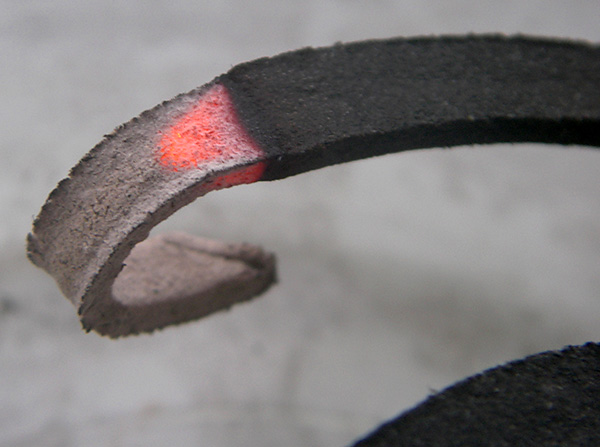
Spirals from mosquitoes and midges should be considered mainly as a means to protect against insect bites at a table on the veranda or in rooms with open windows.
The following brands of insect repellents are quite popular:
- Raptor;
- Mosquitall;
- Neotox;
- Raid;
- Fumitoks.
On a note
Active ingredients of highly effective insect coils may be, for example, d-allethrin and transfluthrin.
Prices for mosquito coils are in the range of 100-250 rubles for a package of 10 spirals.
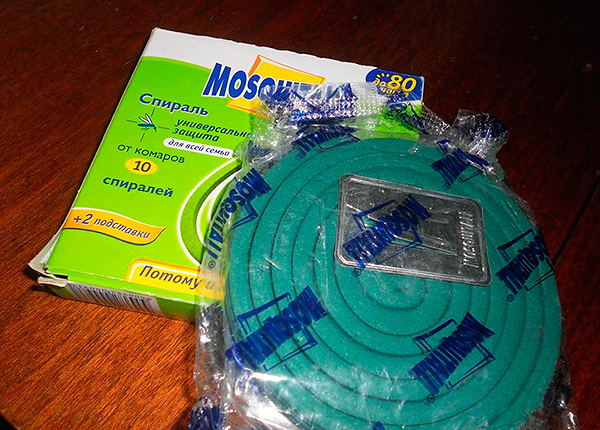
It is useful to keep in mind that although such spirals are considered to be fairly safe for people, nevertheless, in the case of regular and frequent inhalation of insecticidal-repellent smoke of health, this is unlikely to add. And even more so, constantly fumigating living space with them is not worth it.
Electric insect killers
The tools of this group are well suited for protection against mosquitoes both indoors and outside - for example, right next to a private house (veranda, courtyard, terrace). Here the device is connected to the electrical network and attracts insects with the light of an ultraviolet lamp. In front of the lamp there is a metal grid, to which a high voltage is supplied - when flying up to the grid, the insect is destroyed by electric discharge and falls into a special pan, which must be periodically released from the accumulated "corpses".
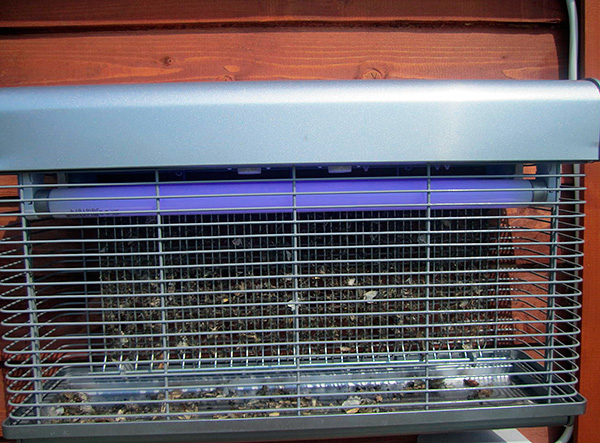
On a note
Electric insect killers have alternative names: an insect lamp, an insect lamp, an electroshock insect killer, a UV trap for mosquitoes, etc.
Important point: the lamp of the device emits a soft ultraviolet and does not ozonize air, so you can not be afraid of the specific smell of ozone in the room. It is also useful to keep in mind that ultraviolet attracts not only mosquitoes, but also flies, moths, moths and some other flying insects - they will all die on the grid.
The following trap brands are quite popular:
- Well - among them there are both small models for the apartment, and street and industrial destroyers of flying insects used on farms and large warehouses;
- Mo El - mostly traps for use in residential areas;
- Hilton - the most budget traps (prices start at 300 rubles).

A small summary: when protecting against insect bites at night, directly inside the room, as well as, for example, near a private house, the tools of this group show quite good efficacy and, importantly, do not harm human health at all, since air insecticides and repellents. However, in the daytime, and especially in conditions of travel to nature, such devices will not protect against the bites of the same mosquitoes.
Ultrasonic Repeller
In general, ultrasonic insect repellents can be attributed to the least effective means, and hope that they will reliably protect in nature from the bites of mosquitoes, mosquitoes, various blackflies and, especially, ticks are not worth it. Ultrasound of low power does not have a pronounced effect on most insects, and the only exception is mosquitoes.

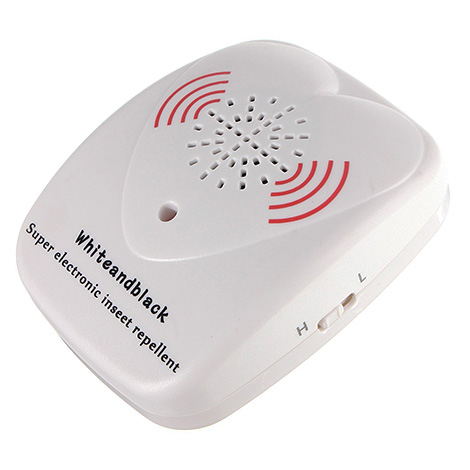
On a note
It is believed that the ultrasound of a certain frequency is perceived by mosquitoes as a danger signal.
Electronic ultrasonic keychains against mosquitoes, produced mainly by the Chinese industry, protect against bites only with a small number of bloodsuckers, and even then not always. In the forest, in the presence of a large number of hungry mosquitoes, such a key will refuse absolutely useless.
More powerful models of ultrasonic repellers protect against mosquito bites in confined spaces and work from the outlet.
Special clothing for protection against insect bites
Instead of using repellent creams, aerosols or smoke bombs in a “mosquito” area, it is often much easier and more effective to cover the body with special clothes, not allowing the bloodsuckers to pick up to the skin.
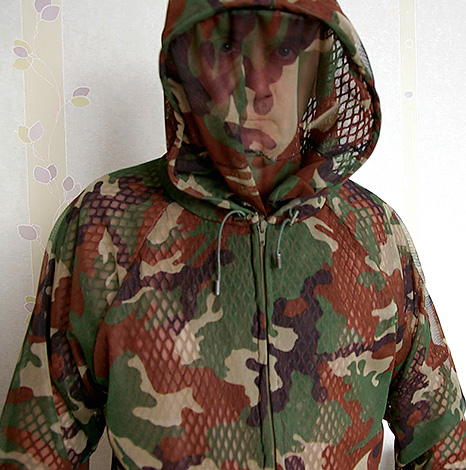
Such a set of protective clothing is simple, cheap and helps protect against insect bites better than using chemical agents. However, in especially hot weather, as well as in the presence of a not very large number of bloodsuckers, it is still easier to splash or apply cream.
On a note
People whose work is associated with a permanent stay in the area with an abundance of midges (geologists, forest workers, biologists) use special very light clothing - wind pants and a jacket made of lightweight materials. The jacket usually has a hood with a net-bed nets, so as not to have to have a beekeeper's mask. Such a suit can be worn over any clothing, or it can simply be placed on a naked body. If the work is associated with constant observations, and nothing should interfere with the eyes, then the face is additionally rubbed with a repellent gel.
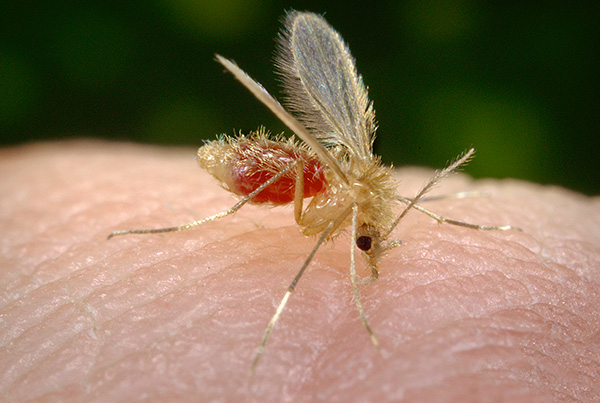
Remedies for ticks: is there any specificity?
To protect against tick bites, commonly used:
- Gels, aerosols and sprays applied to the skin and clothing;
- And also the clothing itself, through which the pincers cannot get through.
The composition of effective remedies for ticks is usually combined - most often used not onlydeterrent substance (for example, repellent DETA), but also insecticides of contact action (alpha-cypermethrin, permethrin). That is, even just crawling on the treated clothes, the tick is already in contact with the poison, which in a few minutes causes paralysis paralysis and subsequent death.
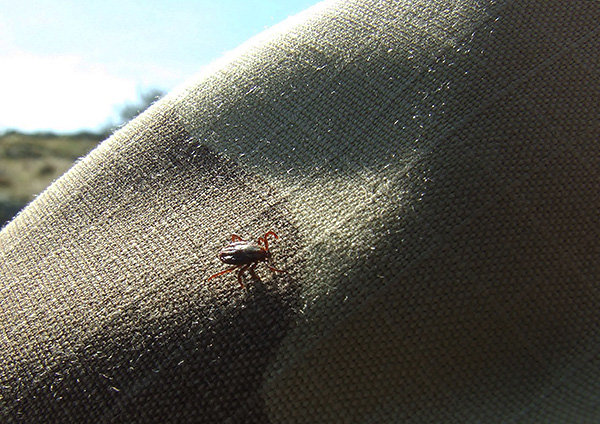
Enough effective remedies for ticks can be found, for example, among the following brands: Mosquitall, Gardex, Taiga, etc.
Clothing for protection against ticks should provide complete protection of the whole body. Socks should be worn on their feet, pants should be tucked in, in which, in turn, a jacket or a jacket should be tucked in. Very often in the forest, ticks fall on a person from branches of trees and shrubs (although some people doubt this), and therefore it is important to be put on a hooded jacket during excursions. On the arms and on the waist of such a jacket there should be elastic bands ensuring a tight fit of the fabric to the skin.
On a note
All this is necessary in areas with a high risk of tick-borne encephalitis. In areas where encephalitis has not been detected, such measures are not mandatory - even if the tick here bites, such a bite will not cause any harm.
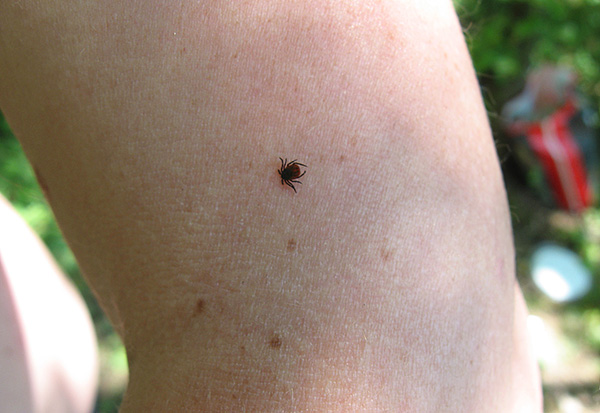
It is also important to remember that even an infected tick transmits the causative agent of the disease only a few hours after the start of bloodsucking. If during a walk or immediately after it carefully inspect the body (it is necessary that someone else did it) and remove ticks that have stuck, then the risk of infection will be minimal. However, it is safer to avoid bites at all.
If the tick has already sucked, you must either squeeze it with your nails as close as possible to the skin, or twist it around with a thread, and then pull it out very carefully. It is advisable before pulling out to slightly roll it in the skin - it does not hurt, but will prevent a possible tearing off of the head, which can remain in the wound and lead to an abscess. You can also burn a tick with a match or a cigarette, or smear it with vegetable oil - in the first case, it will try to detach itself reflexively, in the second - due to lack of oxygen.
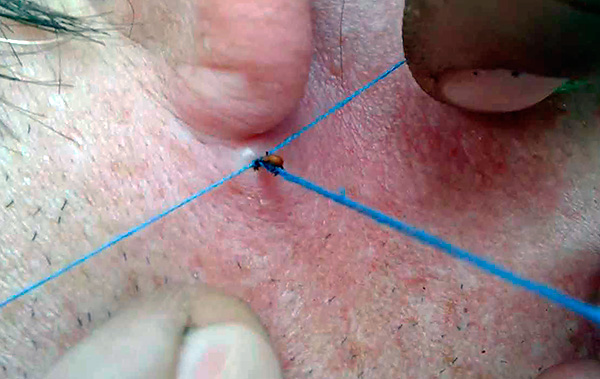
If a sucked tick is removed in an area with high encephalitic danger from a person without an appropriate vaccination, then the bitten one should appear to the doctor. The appearance of nature in such areas without prior vaccination is a gross violation of safety rules.
How to protect against the bites of insect non-parasites?
There are no special means of protection from the bites of wasps, bees, hornets, gadflies and predatory bugs. These insects rarely bite and only in order of self-defense - if they are picked up, inadvertently sit on them or in some way create another threat. In this case, it does not matter at all whether the person will be smeared with a repellent gel.
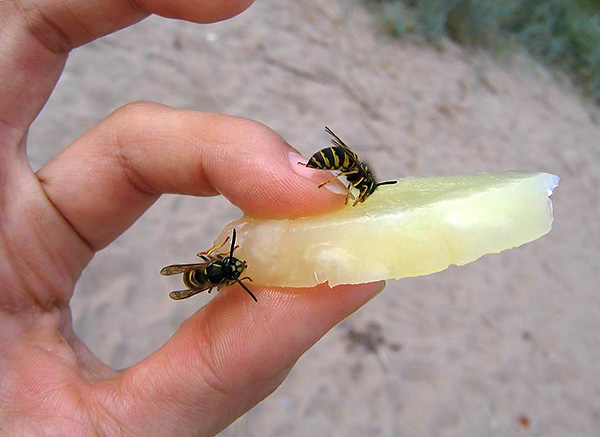
However, the likelihood of insect bites from non-parasites can be reduced by treating the area with the same smoke bombs - wasps and bees will fly away from this place if their nest is not on it. Still, the main protection against such bites is the correct behavior:
- In nature and in the garden you should always check the place where you plan to sit;
- You can not leave open bottles with drinks, and then drink directly from them. Wasps and hornets often climb in the bottlenecks, which can eventually end up in the mouth of a person. It is in such situations that very dangerous bites occur (with compression of the airways due to edema);
- In case of accidental detection of a wasp nest (or a hornet's nest), one should slowly and carefully move away from it, without provoking insects to attack;
- When leaving for a picnic, all sweet, meat and fish products should be kept closed for as long as possible;
- You can not go to bed naked body on the grass (the so-called "earthen wasps", as well as hornets can make their nest under the ground).
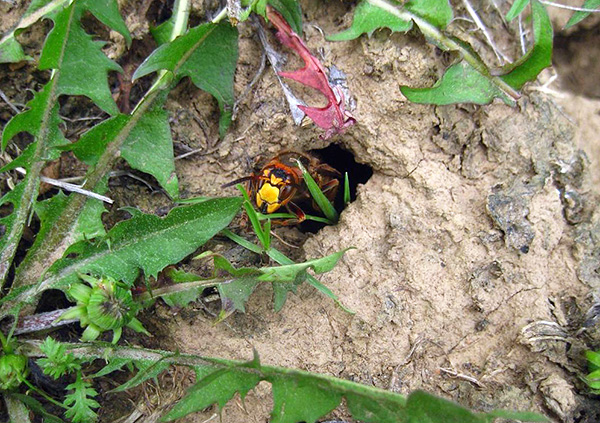
Clothing on the body to some extent protects against the bites of stinging insects. In the summer, T-shirts tucked into light pants are enough to reduce the risk of a wasp sting by 90%.
Rules for choosing tools for different situations
In the end, pick up funds from insect bites should be something like this:
- For protection on an excursion or in a short hike, on a hunt or when working in the country should use the means for applying to the skin or clothing;
- In areas with a high risk of infection with encephalitis, in addition to the use of repellents, you must be dressed in the most closed clothes;
- On a fishing or picnic area, it is advisable to pretreat the insect-repellent smoke bomb;
- When eating on the veranda or in a room with open windows, mosquito coils can be used, and in the dark - an additional tube insect killer;
- In long campaigns in the forest, most of the time you need to be dressed in closed clothes, periodically putting repellent agents on her, as well as on the face and hands.

In addition, it is advisable to have ointments applied after insect bites on any nature trips or cottages, and for people with insect allergies, special autoinjectors with epinephrine (adrenaline) to prevent the development of anaphylactic shock.
Means for treating bites: what to do if you are already bitten?
If we are talking about, for example, such insect parasites as mosquitoes or fleas, then it’s not worth fighting with the consequences of their bites, and they themselves will pass in a few days, or to speed up the process you can:
- Use any medical tool after insect bites - Fenistil gel or Menovazin. For children, Mosquitall and Gardex Family baby products are well suited. When bites of stinging insects of these funds is not always enough, you need to carefully monitor the condition of the affected person, and if necessary, see a doctor;
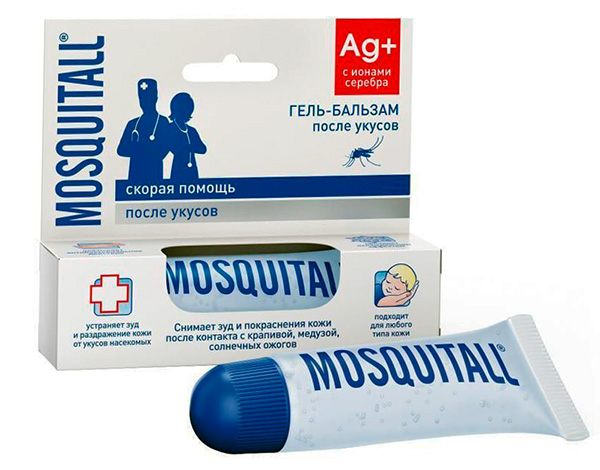

- You can also use folk remedies. Well helps to relieve itching from mosquito bites and bedbugs, cold soda solution, or skin treatment with lemon juice;
- It is believed that some oils also help well after insect bites - castor, aloe, cedar. However, in practice, oils do not always alleviate itching, and some essential oils, on the contrary, may enhance it, irritating damaged skin. For example, the well-known recipe for homemade insect bites pencil, which contains 7 grams of wax, 2 drops of liquid vitamin E and 40 drops of any essential oils - mint, lavender, geranium, pine, is quite questionable in terms of effectiveness ...
If a stinging insect bite has occurred, its place is usually smeared with any anti-inflammatory (Hydrocortisone, Advantan) or anesthetic (for example, Menovazin) ointment. When choosing an ointment, it should be borne in mind that each drug has its own contraindications.
If a bee stings, then before applying any means you must first remove the sting from the wound. If signs of an allergic reaction appear, you should immediately consult with your doctor about further actions (at least by telephone). Sometimes it is necessary to take antihistamines (Suprastin, Erius, Diphenhydramine), and even urgent hospitalization.
On a note
At the site of the tick bite usually remains a large solid bump. If you do not comb it and do not touch it, then it will not disturb the victim, and in a few days will resolve itself. In the case of itching, you can apply the same Advantan or hydrocortisone ointment (contraindications are possible). If after a few days well-defined red circles appeared around the site of the bite, then you need to go to the hospital - this is the first sign of Lyme borreliosis.
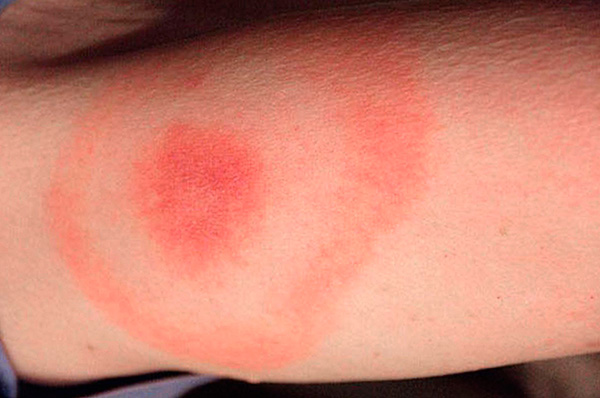
How to avoid leech bites and what to do if you have already bitten?
The main difficulty of protection against leeches lies in the fact that they live in water, and here all protective agents are quickly washed away from human skin. Funds with 20% content of DEET reliably protect against leeches in wet grass, but more often these parasites attack bathers and fishermen in standing reservoirs. Absolutely reliable protection from them here - rubber boots or a wetsuit (including hydraulic socks).
Leech bites are unpleasant in the first place, profuse bleeding. To prevent it, it is advisable to sprinkle the wound with a vasoconstrictor for the nose - Naphthyzinum or Galazolin (contraindications are possible), and then attach a dense cotton compress to it and roll it tight with a bandage.

Well, be careful when resting in the woods or in the country, use the right insect repellent and enjoy nature without fear of parasites!
If you have personal experience with using certain means to protect against insect bites, do not forget to leave your feedback at the bottom of this page (in the comments box).
Useful video: how to escape from insect bites
An example of the use of smoke bombs Quiet Evening from mosquitoes in nature

